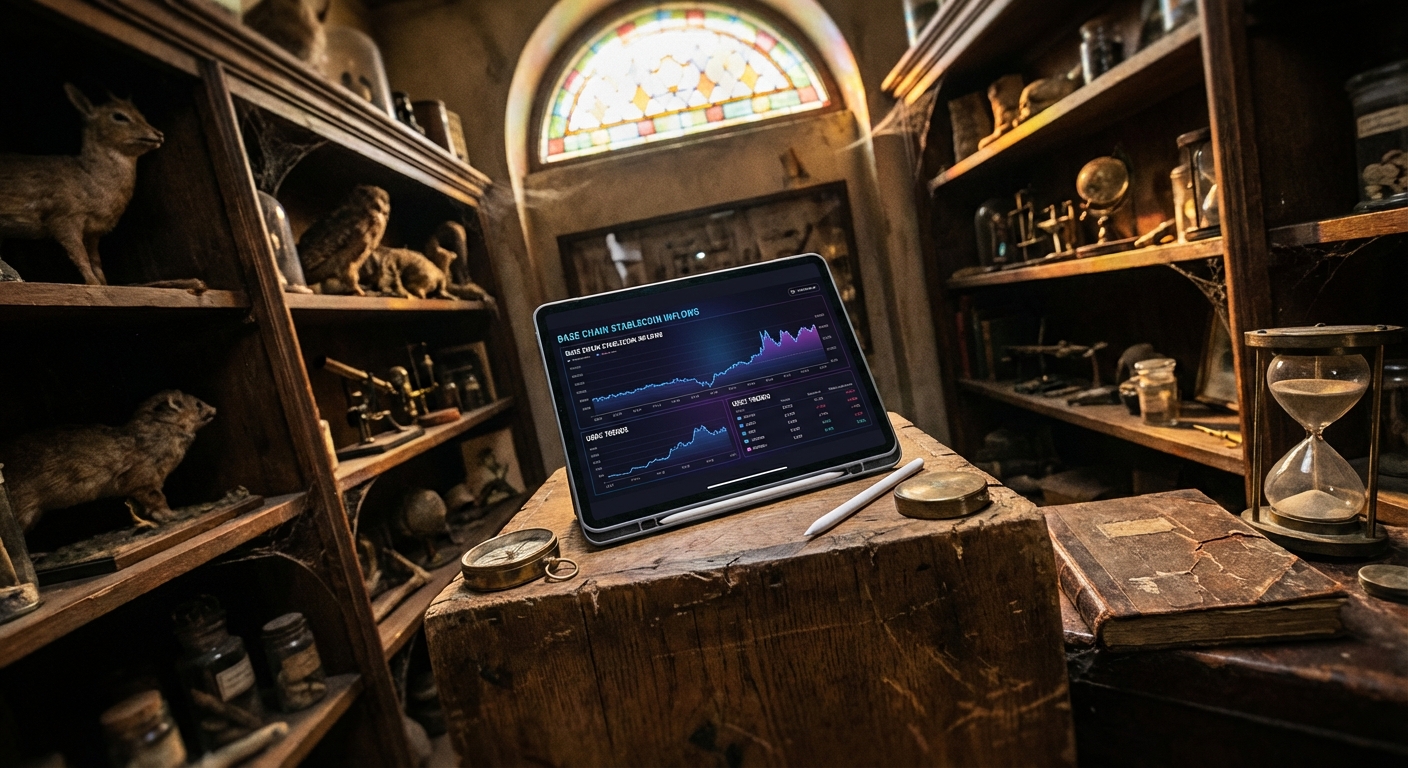USDC Base is rewriting the script for stablecoin adoption on Ethereum Layer 2, and investors are taking notice. With a 1,055.9% surge in USDC supply on Base over just 90 days (as of June 2024) and single-day transfer volumes touching $15 billion in October 2024, the metrics behind this explosive growth are more important than ever for anyone looking to capitalize on crypto’s next big move. But how do you actually track the pulse of USDC Base flows in real time? Let’s break down the five essential on-chain metrics every investor should have on their dashboard.
Why USDC Base Flows Matter Right Now
Base has rapidly become a magnet for stablecoin activity, accounting for 36% of all USDC transfers at its October 2024 peak (source). This isn’t just noise – it’s a signal that liquidity, user adoption, and institutional capital are converging here. Yet, July 2025 saw a sharp reversal with net outflows of $4.3 billion through cross-chain bridges (source). For crypto investors, these swings can mean opportunity or risk – depending on how well you track the key numbers.
Cryptocurrency Price Comparison: USDC Base vs. Major Stablecoins & Assets
Real-time price comparison of USDC (Base), Multichain Bridged USDC (Fantom), native USDC across blockchains, and leading cryptocurrencies to highlight price stability and market trends (as of 2025-09-19).
| Asset | Current Price | 6 Months Ago | Price Change |
|---|---|---|---|
| USDC (Base) | $1.00 | $1.00 | +0.0% |
| Multichain Bridged USDC (Fantom) | $0.0486 | $0.0486 | +0.0% |
| USDC (Ethereum) | $1.00 | $1.00 | +0.0% |
| USDC (Solana) | $1.00 | $1.00 | +0.0% |
| Tether (Ethereum) | $1.00 | $1.00 | +0.0% |
| Dai (Ethereum) | $1.00 | $1.00 | +0.0% |
| Bitcoin | $115,779.00 | $60,000.00 | +93.0% |
| Ethereum | $4,468.06 | $3,000.00 | +48.9% |
Analysis Summary
Stablecoins such as USDC (Base), USDC (Ethereum), USDC (Solana), Tether, and Dai have maintained their $1.00 peg over the past six months, showing no significant price changes. In contrast, Multichain Bridged USDC (Fantom) remains depegged at $0.0486. Meanwhile, Bitcoin and Ethereum have experienced substantial gains, up +93.0% and +48.9% respectively, reflecting strong bullish momentum in the broader crypto market.
Key Insights
- USDC (Base) and other major stablecoins have maintained perfect price stability, consistently trading at $1.00 over the last six months.
- Multichain Bridged USDC (Fantom) remains severely depegged, trading at just $0.0486, highlighting significant risk for holders and no arbitrage opportunity back to $1.00.
- Bitcoin and Ethereum have outperformed all stablecoins in terms of price appreciation, with Bitcoin nearly doubling in value (+93.0%) and Ethereum up nearly 50% (+48.9%) over the same period.
- No price discrepancies exist among native USDC assets across Base, Ethereum, and Solana, indicating efficient cross-chain arbitrage and robust peg maintenance.
All prices and changes are sourced directly from the provided real-time market data as of September 19, 2025. Only assets with explicit real-time data are included, and all figures reflect exact values without estimation.
Data Sources:
- Main Asset: https://www.coingecko.com/en/coins/usd-coin
- Multichain Bridged USDC (Fantom): https://www.coingecko.com/en/coins/multichain-usd-coin
- USDC (Ethereum): https://www.coingecko.com/en/coins/usd-coin
- USDC (Solana): https://www.coingecko.com/en/coins/usd-coin
- Tether (Ethereum): https://www.coingecko.com/en/coins/tether
- Dai (Ethereum): https://www.coingecko.com/en/coins/dai
- Bitcoin: https://www.coingecko.com/en/coins/bitcoin
- Ethereum: https://www.coingecko.com/en/coins/ethereum
Disclaimer: Cryptocurrency prices are highly volatile and subject to market fluctuations. The data presented is for informational purposes only and should not be considered as investment advice. Always do your own research before making investment decisions.
The Five Key Metrics to Track USDC Base Flows
Five Must-Watch Metrics for Tracking USDC Base Flows
| Metric Name | Description | Why It Matters | Example Data |
|---|---|---|---|
| Net USDC Base Inflows/Outflows (24h, 7d) 🔄 | Measures the total amount of USDC entering and leaving the Base network over daily and weekly intervals. | Reveals investor sentiment and liquidity trends; large outflows may signal risk-off behavior. | July 2025: Net outflow of $4.3 billion in a week |
| Active USDC Base Wallets 👛 | Counts unique wallets transacting with USDC on Base. | Higher numbers indicate growing adoption and user engagement. | October 2024: Over 1 million active wallets in a month |
| USDC Base Exchange Balances 🏦 | Tracks total USDC held on both centralized and decentralized exchanges on Base. | Helps assess potential buying/selling pressure and liquidity available for trading. | June 2024: Exchange balances surged 1,055.9% over 90 days |
| Large Transactions Volume (>$100k) 🐋 | Monitors volume of USDC transfers above $100,000 on Base. | Highlights institutional activity or whale movements, which can precede major price shifts. | October 2024: Single-day volume reached nearly $15 billion |
| USDC Supply Distribution by Holder Type 🧑💼🦈🤖 | Analyzes how USDC is split among whales, retail users, and smart contracts. | Indicates market concentration and risk; high whale concentration can increase volatility. | Base: 36% of all USDC transfers in October 2024, with whales holding a significant share |
1. Net USDC Base Inflows/Outflows (24h, 7d):
This metric measures the total amount of USDC entering and leaving the Base network over specific periods. Spikes in net inflows signal fresh capital pouring into the ecosystem – often bullish for DeFi protocols and token prices. Conversely, sustained outflows like July’s $4.3 billion can foreshadow liquidity crunches or shifting sentiment. Monitoring these flows helps investors anticipate market moves before they hit headlines.
2. Active USDC Base Wallets:
Tracking the number of unique wallets transacting with USDC on Base gives you a front-row seat to adoption trends and user engagement. A rising wallet count means more participants are using stablecoins for trading, payments, or yield strategies – all positive signs for network health. Flat or declining numbers could point to waning interest or consolidation among larger players.
Diving Deeper: Exchange Balances and Whale Activity
3. USDC Base Exchange Balances:
This stat shows how much USDC is currently held across centralized and decentralized exchanges operating on Base. When balances climb, it often means users are gearing up to trade or potentially sell – watch out for increased volatility or downward price pressure if supply overwhelms demand.
If balances drop sharply while price holds steady (like Multichain Bridged USDC trading at $0.04861126 as of September 19,2025), it could indicate accumulation by long-term holders moving coins off-exchange into self-custody or DeFi protocols.
4. Large Transactions Volume ( and gt;$100k):
When whales move, markets react! Tracking large-value transfers can reveal when institutions or high-net-worth players are repositioning ahead of major events or volatility spikes.
A sudden uptick in and gt;$100k transactions often precedes price swings – especially if paired with changing exchange balances or net inflow trends.
Multichain Bridged USDC (Fantom) Price Prediction 2026–2031
Professional forecast based on current flow metrics, adoption trends, and market scenarios for investors
| Year | Minimum Price | Average Price | Maximum Price | Year-over-Year Change (Avg) | Key Scenario |
|---|---|---|---|---|---|
| 2026 | $0.044 | $0.050 | $0.057 | +3.0% | Stabilization after capital outflows; regulatory clarity expected |
| 2027 | $0.038 | $0.047 | $0.060 | -6.0% | Bearish scenario if capital outflows continue; competition from native USDC |
| 2028 | $0.042 | $0.052 | $0.068 | +10.6% | Adoption rebound as cross-chain use cases mature |
| 2029 | $0.045 | $0.055 | $0.072 | +5.8% | Increased interoperability and onchain utility |
| 2030 | $0.047 | $0.059 | $0.076 | +7.3% | Market recovery, improvements to CCTP, and new RWA integrations |
| 2031 | $0.050 | $0.064 | $0.083 | +8.5% | Bullish scenario: Multichain demand surges, regulatory frameworks solidify |
Price Prediction Summary
The Multichain Bridged USDC (Fantom) is forecasted to see gradual stabilization and moderate growth after significant capital outflows in 2025. While bearish scenarios remain possible due to competition from native USDC and regulatory uncertainty, the protocol’s utility in cross-chain transactions and expanding DeFi use cases support a recovery and potential upside from 2028 onward.
Key Factors Affecting USD Coin Price
- Capital flows between Base, Fantom, and other chains
- Regulatory developments affecting stablecoin bridges
- Adoption of Circle’s CCTP and cross-chain protocols
- Competition from native USDC and other stablecoins
- Macro crypto market cycles and institutional adoption
- Technological improvements in bridging and interoperability
Disclaimer: Cryptocurrency price predictions are speculative and based on current market analysis.
Actual prices may vary significantly due to market volatility, regulatory changes, and other factors.
Always do your own research before making investment decisions.
The Hidden Power Metric: Supply Distribution by Holder Type
The fifth metric is your X-ray vision into market concentration and risk exposure. . .
This is where things get interesting. USDC Supply Distribution by Holder Type breaks down who actually controls the stablecoin supply on Base, whales, retail users, or smart contracts. Why does this matter? If a handful of whales dominate the supply, the ecosystem is vulnerable to sudden dumps or coordinated moves. On the flip side, broader distribution among many wallets or integration with DeFi protocols signals a healthier, more resilient market structure.
For example, a surge in USDC held by smart contracts might reflect increased DeFi adoption on Base, think lending platforms, DEX liquidity pools, or automated trading strategies locking up capital for yield. Meanwhile, a rising share among retail wallets could point to growing grassroots demand and real-world use cases like payments and remittances. By regularly checking this metric alongside net inflows and exchange balances, you’ll spot early warning signs of risk concentration or catch bullish trends before they become consensus.

How to Put These Metrics Into Action
Don’t just watch these numbers, use them! Here’s how savvy investors leverage USDC Base flow analytics for actionable insights:
- Spot trend reversals: A sudden flip from net inflows to outflows (or vice versa) often precedes major price moves across DeFi tokens and L2 assets.
- Gauge market sentiment: Rising active wallet counts and decentralized exchange balances typically signal bullish sentiment and fresh user engagement.
- Front-run whale activity: Monitor large transactions for clues about institutional positioning before headlines hit.
- Avoid liquidity traps: Sharp drops in exchange balances can warn of drying liquidity or whales exiting positions, time to tighten risk management.
- Assess systemic risk: Use supply distribution data to avoid overexposed ecosystems where a few players hold all the cards.
Final Thoughts: Stay Ahead of the Curve
The stablecoin landscape is evolving at warp speed, and with USDC Base flows hitting record highs (and lows), there’s no room for guesswork. By anchoring your strategy around these five key metrics, Net Inflows/Outflows, Active Wallets, Exchange Balances, Large Transactions Volume, and Supply Distribution, you’ll have a data-driven edge in navigating volatility and spotting opportunity before the crowd.
If you want to dive deeper into live numbers or explore cross-chain analytics (like Circle’s CCTP v2), check out resources like the Binance Square report, CoinDesk coverage, or track token stats directly via Frontier Lab’s deep dive.
The bottom line? The numbers never lie, track them relentlessly and let them lead your next move.






